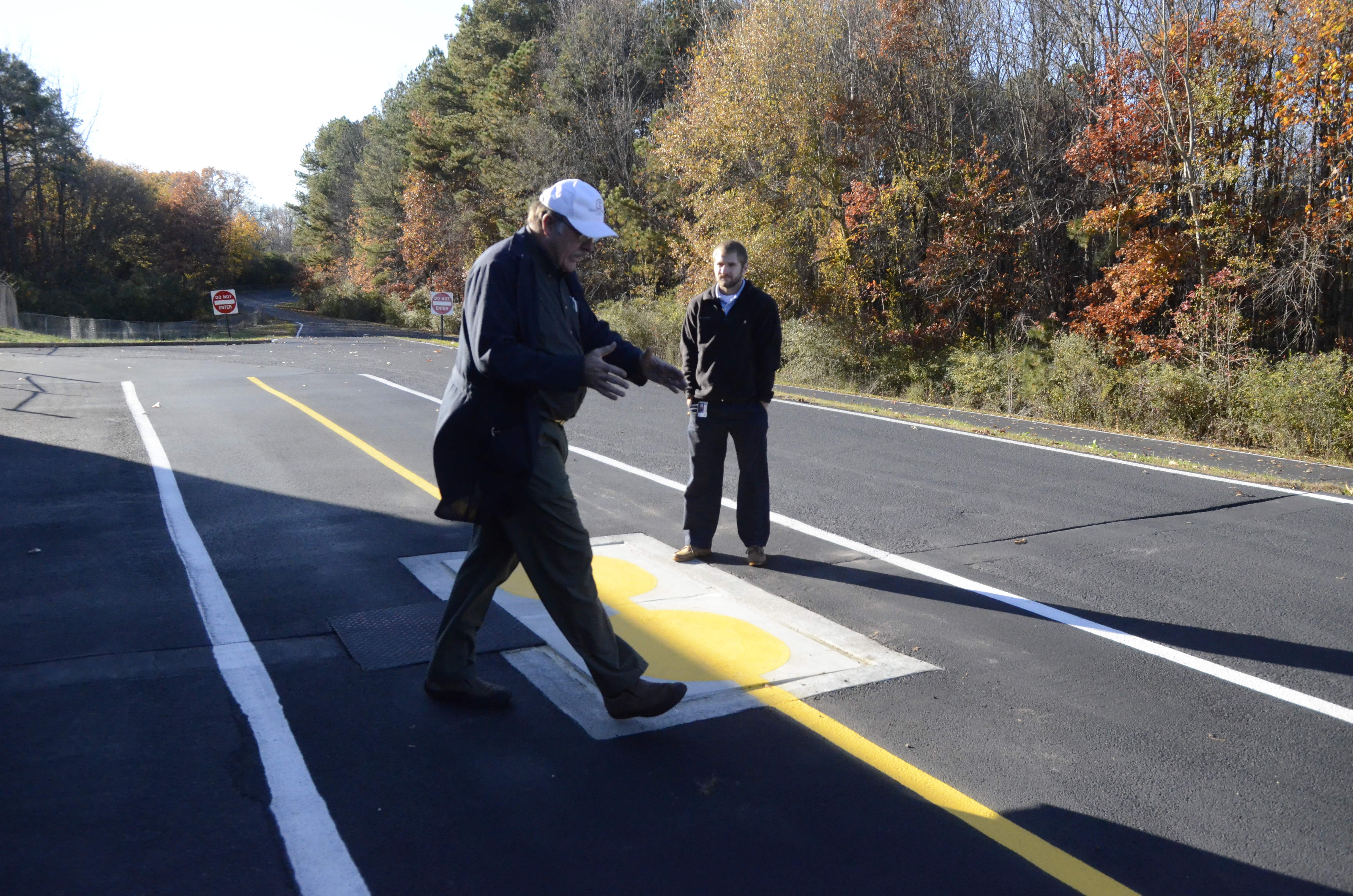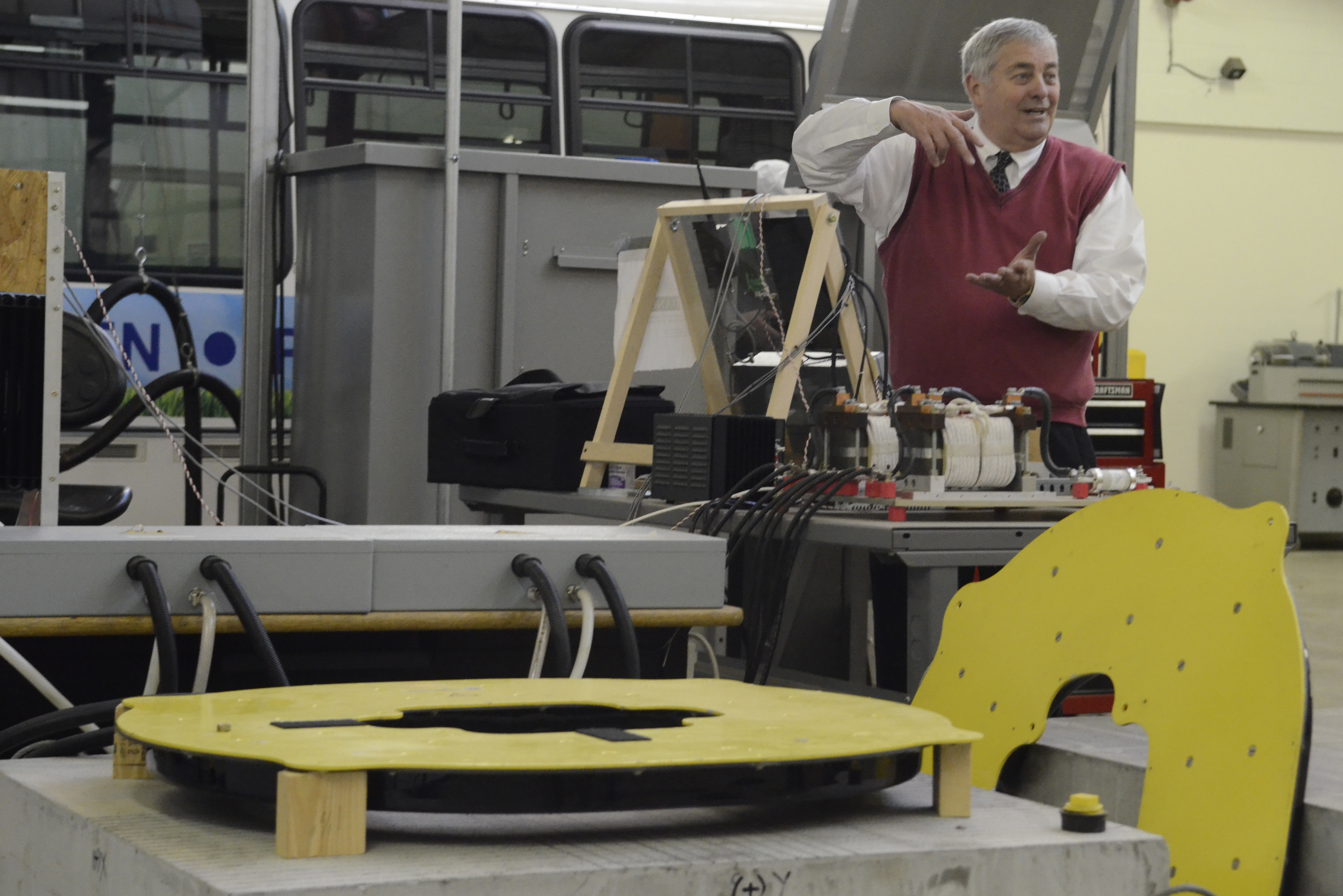 Stephen Smith, a consultant with Embedded Power Co., left, and Drew Frye, power utilization engineer for TVA's transportation infrastructure group, show an underground charging station being used at the TVA electric vehicle testing center. The UTC engineering department is working with CARTA to test the wireless charging technology.
Stephen Smith, a consultant with Embedded Power Co., left, and Drew Frye, power utilization engineer for TVA's transportation infrastructure group, show an underground charging station being used at the TVA electric vehicle testing center. The UTC engineering department is working with CARTA to test the wireless charging technology.Some of CARTA's electric buses are about to break free of their batteries, using technology that could spell the end of the transit agency's whole diesel fleet.
A $2.5 million federal grant announced Thursday will pay for three battery-powered electric buses that can recharge in minutes - in a garage or a streetside pulloff - and run city streets all day at 20 percent of the cost of running diesel buses.
The technology, called wayside induction, consists of two sets of electric coils, one buried in a garage floor, parking lot or street pulloff and the other mounted on the bus. The bus hunkers over the buried coil, the driver hits a switch and electricity flows wirelessly into the battery.
The electric buses now on the streets can go about 45 miles on a charge. A bus that could go more than 100 miles could be used on any CARTA route, not just the downtown loop, without a time-consuming battery change, CARTA Executive Director Tom Dugan said.
Announcing the grant Thursday, U.S. Transportation Secretary Ray LaHood said Chattanooga's 20-year history of electric vehicle research and development figured heavily in the award through the Transit Investment in Greenhouse Gas and Energy Reduction grant program.
"That's one of the reasons why Chattanooga was awarded this grant," LaHood said in a conference call.
The grant program "is all about trying to develop cutting-edge technology," he said. "What we learn in Chattanooga will be distributed to transit agencies across the nation."
Chattanooga's grant was among 46 totaling $112 million.
In a conference call tinged with election-season political rhetoric, LaHood said the projects "will put people back to work building sustainable, energy-efficient vehicles in 23 states."
"The American people are ready and waiting for Congress to take action that will put people back to work, that will help people get where they need to go and will address pressing environmental issues such as climate change," he said.
 Photographed Thursday at TVA's electric vehicle testing center near the Chickamauga Dam, Ron Bailey, Guerry professor of engineering at UTC, explains the wireless charging technology that is being tested for use in CARTA electric buses. Charging coils installed in the pavement along the bus route will allow buses to receive a charge in three minutes that will propel the bus for three miles, meaning that CARTA can operate the downtown shuttle using fewer buses and batteries.
Photographed Thursday at TVA's electric vehicle testing center near the Chickamauga Dam, Ron Bailey, Guerry professor of engineering at UTC, explains the wireless charging technology that is being tested for use in CARTA electric buses. Charging coils installed in the pavement along the bus route will allow buses to receive a charge in three minutes that will propel the bus for three miles, meaning that CARTA can operate the downtown shuttle using fewer buses and batteries.On the three new buses that CARTA will get with the grant, recharge time is one minute per mile, so a driver on the three-mile loop between the Tennessee Aquarium could recharge while picking up passengers at each end of the route and, theoretically, keep driving all day.
The goal has been what the testers call "one mile, one minute, one dime" - that is, hauling 20 bus passengers a mile and recharging for one minute at a cost of 10 cents.
That's compared with 50 cents a minute for diesel buses, Dugan said. An all-electric fleet would save 80 percent of current fuel costs, or $1.5 million a year, he said.
"This is very much, to us, a way of making electric vehicles go further on a charge," Dugan said. "It would save us a significant amount of money and reduce the number of vehicles we have to use."
The three buses - plus a $600,000 local match from Chattanooga and the state of Tennessee - will be put in service on downtown routes. Dugan expects they'll actually go into service in 2014.
A partnership between CARTA and the Center for Energy, Transportation and the Environment at the University of Tennessee at Chattanooga has tested the technology at TVA's Electric Vehicle Test Center by Chickamauga Dam and on city streets.
Ron Bailey, Guerry professor of engineering at UTC, is head of the test team and said the system operates on a well-contained electromagnetic field that is 95 percent efficient.
"The electromagnetic fields created [when the coils are operating] are far less than what you get from a microwave oven," Bailey said.
Improving battery technology is as important to the project as the induction coils, Bailey said. The nickel-acid batteries that CARTA buses use now go 35 to 45 miles on a charge while a type of lithium ion battery in a test vehicle has gone 150 miles, Bailey said.
Stephen Smith, with Coalsmith Consultants, is also on the test team. Steering another test vehicle around the track Thursday, Smith acknowledged that generating electricity to power electric vehicles doesn't come without environmental costs since that power comes from coal-fired plants.
But he said there would be a net emissions gain, even from coal-fired power plants, if the plants were modern and efficient.
But test team members and Dugan all said electric battery technology is only a stopgap.
By 2050, they said, experts are predicting that most vehicles will run on hydrogen, whose only combustion byproduct is water.
